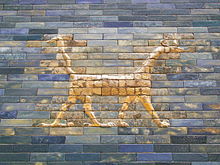- Mušḫuššu
-
Mušḫuššu
Sirrush bas-relief in the Pergamon Museum.Creature Grouping mythological hybrid Sub grouping Dragon Similar creatures Hydra Data Mythology Babylonian mythology Region Mesopotamia The mušḫuššu (also known as sirrušu, sirrush) is a creature depicted on the reconstructed Ishtar Gate of the city of Babylon, originally dating to the 6th century B.C. It is a mythological hybrid, a scaly dragon with hind legs like an eagle's talons and feline forelegs. It also has a long neck and tail, a horned head, a snakelike tongue and a crest.
The Akkadian name muš-ḫuššu loosely translates to "splendor serpent." The variant sir-ruššu is due to a mistransliteration in early Assyriology.[1]
Contents
History
 The Ishtar Gate.
The Ishtar Gate.
Mušḫuššu is associated with Marduk. It gave rise to the Lernaean Hydra of Greek mythology and ultimately to the modern Hydra constellation.
Bel and the Dragon, a deuterocanonical Biblical text, relates a story that Koldewey thought involved a sirrush. In a temple dedicated to Bel (Nebuchadnezzar's god), priests had a "great dragon or serpent, which they of Babylon worshiped."
Daniel, the protagonist of the Book of Daniel, was confronted with this creature by the priests in the apocryphal text. (see Additions to Daniel) They challenged him to match his invisible God against their living god. Eventually, Daniel poisoned the creature.
Cryptozoology
Further information: living dinosaurs and Mokele-mbembeGerman archeologist Robert Koldewey, who discovered the Ishtar Gate in 1902, seriously considered the notion that the sirrush was a portrayal of a real animal. He argued that its depiction in Babylonian art was consistent over many centuries, while those of mythological creatures changed, sometimes drastically, over the years. He also noted that the sirrush is shown on the Ishtar Gate alongside real animals, the lion and the rimi (aurochs), leading him to speculate the sirrush was a creature the Babylonians were familiar with. The creature's distinctly feline front paws seemed incongruous, and gave Koldewey some doubt. However, In 1918 he proposed that the iguanodon, (a dinosaur with birdlike hindfeet) was the closest match to the sirrush (Sjögren, 1980).
Cryptozoological speculation regarding sirrush was also presented by Adrienne Mayor[citation needed] and Bernard Heuvelmans[2].
See also
References
- ^ The Assyrian Dictionary, vol. 10 part II, p. 270.
- ^ Mysterious creatures: a guide to cryptozoology, Volume 1, George M. Eberhart, ABC-CLIO, 2002, p. 2003
Bibliography
- Jerome Clark (1993). Unexplained! 347 Strange Sightings, Incredible Occurrences, and Puzzling Physical Phenomena. Detroit: Visible Ink Press.
- Bernard Heuvelmans (1958). On The Track Of Unknown Animals. New York: Hill and Wang.
- Willy Ley (1959). Exotic Zoology. New York: Viking Press.
- Karl Shuker (1995). In Search of Prehistoric Survivors. London: Blandford. ISBN 0-7137-2469-2
- Bengt Sjögren (1980). Berömda vidunder, Settern ISBN 91-7586-023-6 (Swedish)
External links
- Mushrushu (or Sirrush) artwork from Ishtar Gate & lore
- The Ishtar Gate
- The Cryptid Zoo: Sirrush in Cryptozoology
Categories:- Babylonian art and architecture
- Mesopotamian legendary creatures
- Dragons
- Archaeological artefacts
- Mythological hybrids
Wikimedia Foundation. 2010.

